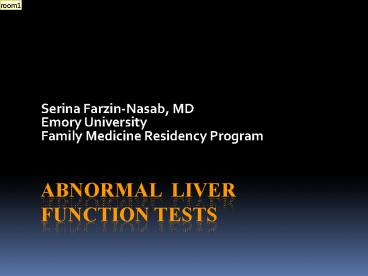Abnormal Liver Function Tests - PowerPoint PPT Presentation
1 / 35
Title:
Abnormal Liver Function Tests
Description:
Title: M&M Author: Martin Khabbaz Last modified by: Family & Preventive Medicine Created Date: 12/14/2005 2:38:12 AM Document presentation format – PowerPoint PPT presentation
Number of Views:312
Avg rating:3.0/5.0
Title: Abnormal Liver Function Tests
1
Abnormal Liver Function Tests
- Serina Farzin-Nasab, MD
- Emory University
- Family Medicine Residency Program
2
- 3 Categories
- 1- Direct hepatocellular damage (transaminases)
- 2-Cholestasis ( bilirubin, alkaline phosphates)
- 3-Livers synthetic ability ( albumin, PT)
3
- Transaminitis
- Hepatocyte necrosis leads to leakage of enzyme
- Hepatitis
- Toxic injury
- Ischemic injury
4
- Hep C liver cell death by apoptosis (programmed
cell death) and by necrosis - 1/3 pts with Hep C have persistently normal
serum transaminases
5
- Levels of aminotransferases can rise in Severe
muscular exertion or other muscle injuries,
polymyositis - Hypothyroidism
6
- AST and ALT levels do not follow a normal
bell-shaped distribution - AST and ALT are higher in obese pts, males
and nonwhites ( blacks and Hispanics)
7
- Causes of Elevated ALT or AST Values in
Asymptomatic Patients - A) Autoimmune hepatitis
- B) Hepatitis B
- C) Hepatitis C
- D) Drugs or toxins
- E) Ethanol
- F) Fatty liver
8
- G) Growths (tumors)
- H) Hemodynamic disorder (congestive heart
failure) - I) Iron (hemochromatosis), copper (Wilson's
disease) or alpha1-antitrypsin deficiency - M) Muscle injury
9
- Typical AST or ALT Values in Disease
10
MARKERS OF CHOLESTASIS
- Cholestasis reflected in abnormal bilirubin and
AP levels - In acute bile duct obstruction from a gallstone,
AST and ALT levels often reach 500 U per L or
more in the first hours , whereas AP and GGT
levels can take several days to rise.
11
- Elevation of GGT alone results from enzyme
induction by alcohol or aromatic medicatios - GGT is elevated in persons who drink 3 or more
per day
12
Direct/conjugated hyperbilirubinemia
- Conjugated bilirubin levels do not rise until the
liver has lost approximately half of its
excretory ability. - The presence of conjugated bilirubin in the urine
( urine dipstick), is always indicative of
hepatobiliary disease .
13
Indirect/uncongealed Hyperbilirubinemia
- Gilbert syndrome
- Common benign inherited disorder
- Levels between 2 and 3 mg/d
- Patients develop detectable jaundice during
acute illness or starvation
14
- Hemolysis
- Confirmed by an elevated retic count increased
haptoglobin levels. - In adults, no serious liver disease will
- cause elevation of indirect bili alone
without a concurrent rise in direct bili levels.
15
AP
- Elevated levels are found in adolescents,
children (secondary to bone growth), and pregnant
women - Women with persistently elevated AP levels
- primary biliary cirrhosis
- Confirmed by a serum antimitochondrial antibody
test
16
Hepatic Cause of elevated AP
- Hepatocellular disease (usually lt3-fold increase)
- Alcoholic hepatitis
- Viral hepatitis
- Fatty infiltration of liver
- Cirrhosis
17
Hepatic Cause of elevated AP
- Obstructive processes (usually gt3-fold increase)
- Choledocholithiasis
- Cancer of head of pancreas
- Cholangiocarcinoma
- Cholestatic hepatitis
18
Hepatic Cause of elevated AP
- Infiltrative, neoplastic, Primary or metastatic
carcinomas (15- to 20-fold increase) - Primary biliary cirrhosis
- Amyloidosis
- Hepatic congestion caused by heart disease
- Infectious mononucleosis
19
Hepatic Cause of elevated AP
- Medications
- Captopril
- Erythromycin
- Gold salts
- Phenothiazines
- Trimethoprimand-sulfamethoxazole
- Anticonvulsants
20
- Increased synthesis of AP in Diabetes mellitus
- 44 of patients with DM have increased AP
21
Common Non hepatic Causes of Elevated GGT
- Acetaminophen overdose
- Acute myocardial infarction
- Acute pancreatitis
- Anticonvulsants (phenytoin, phenobarbital,
- carbamazepine)
22
- Brain tumor
- Diabetes mellitus
- Hyperthyroidism
- Infectious mononucleosis
- Epilepsy
23
Albumin
- An Index of liver synthetic capacity
- Low albumin level and no other LFT
- abnormalities are likely to have a non hepatic
cause
24
Albumin
- Non hepatic causes of low Albumin
- Inflammatory states such as burns, trauma,
- sepsis
- Active rheumatic disorders
- Severe end-stage malnutrition
- Pregnancy
- Proteinuria
25
PT
- Does not become abnormal until more than 80of
liver synthetic capacity is lost - Useful to be followed in acute hepatic failure
- (Factor 7 has very short half life)
26
PT
- Vitamin K deficiency
- Chronic cholestasis or fat malabsorption
- A trial of vitamin K injections ( 5 mg /day SQ x
3 days) practical way to exclude vitamin K
deficiency - PT should improve within a few days
27
Ammonia
- Concentrations are much higher in the brain than
in the blood and therefore do not correlate well - It is not unusual for the blood ammonia to be
normal in a patient who is in a coma from hepatic
encephalopathy.
28
QUIZ
- Other than hepatitis, causes of elevated
- serum GGT include all of the following except
- A. Diabetes mellitus.
- B. Hypothyroidism.
- C. Brain tumor.
- D. Infectious mononucleosis.
- E. Acute myocardial infarction
29
- Answer B
- Hyperthyroidism is associated with
- elevated GTT
30
QUIZ
- The greatest increase in serum alkaline
- phosphatase is generally seen in a patient
- with which of the following conditions?
- A. Primary biliary cirrhosis.
- B. Alcoholic hepatitis.
- C. Viral hepatitis.
- D. Fatty infiltration of the liver.
- E. Cancer of the head of the pancreas
31
- Answer A
- Primary billiary cirrhosis
32
QUIZ
- In patients with viral hepatitis, the serum
AST level is usually higher than the serum ALT
level - A. True.
- B. False
33
- False
34
QUIZ
- Normally, most of the total bilirubin is
conjugated. - A. True
- B. False
35
- False
- 70 of total Billi is non conjugated































